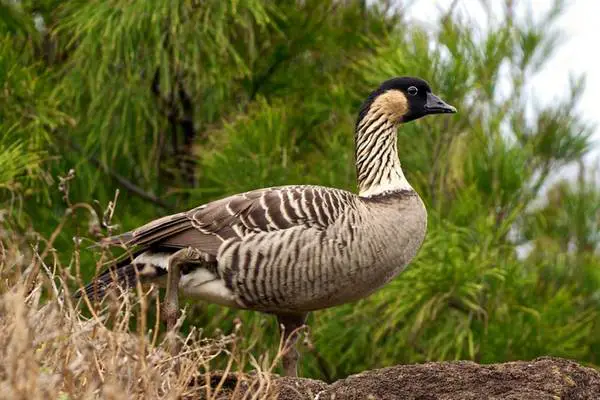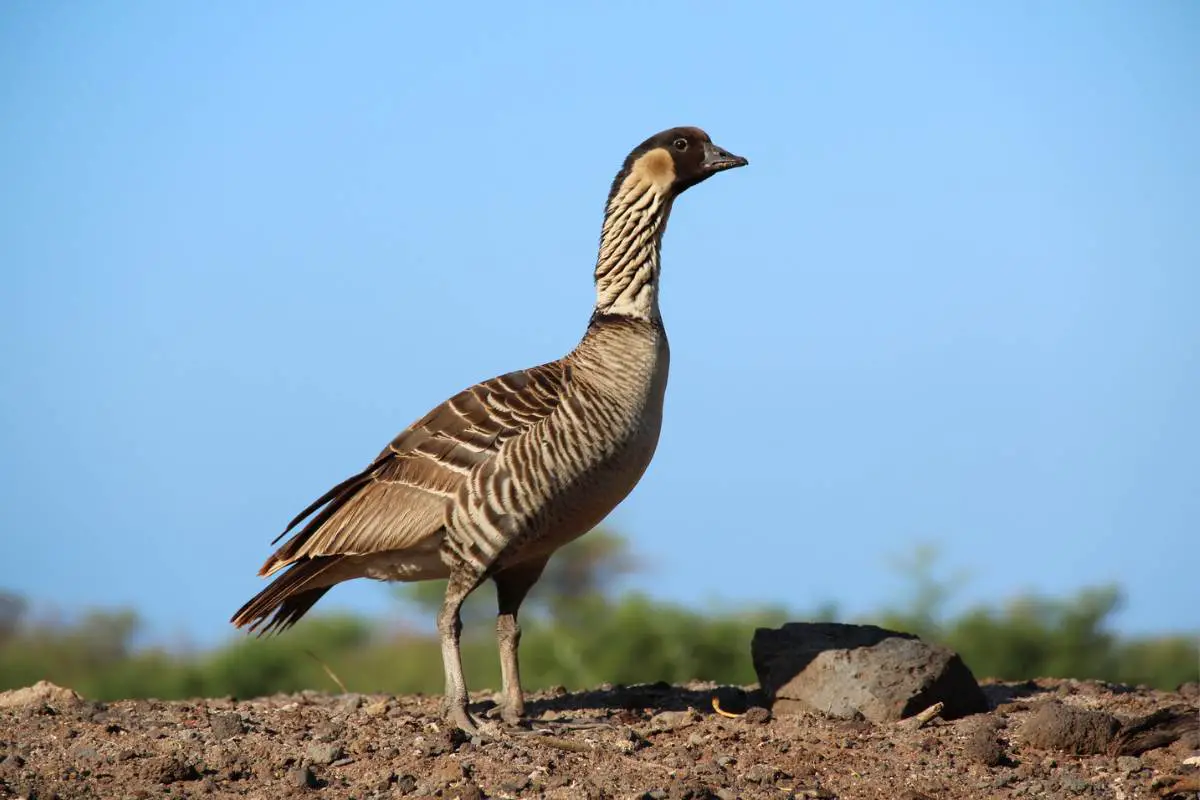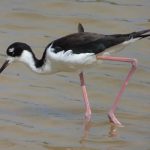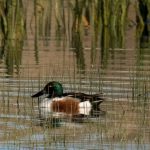Common Name: Nene
Scientific Name: Branta sandvicensis| Size | Diet | Range in Hawaii | Status in Hawaii |
|---|---|---|---|
| 20 in. - 28 in. | grasses, sedges, and other herbaceous plants | Big Island, Kaua'i, Moloka'i, Lana'i, and O'ahu | Near Threatened |
The Nene (Branta sandvicensis), also known as the Hawaiian goose, is a species of goose that is native to the Hawaii. It is the state bird of Hawaii and are found on the islands of Big Islands, Kaua’i, Moloka’i, Lana’i, and O’ahu.
The Nene is closely related to other species of geese and is thought to have evolved from Canada geese that colonized the Hawaiian Islands millions of years ago. It is a symbol of the unique natural history of Hawaii and is an important part of the local culture and traditions.
Nene
Appearance

Nene has a black head and neck and a white collar, as well as a black chest and back. The Nene has a short, stout bill and long, strong legs that are well adapted to the rugged terrain of the Hawaiian Islands.
It has sharp claws that help it to grip the rocky slopes and a short tail that is often held erect. The Nene has a wingspan of about 3 feet and weighs between 3 and 7 pounds.
The female Nene is slightly smaller than the male. They typically measures between 20 and 28 inches in length. This includes the length of the body and the neck.
Diet
The Nene is a herbivorous bird that feeds on a variety of plants. It primarily feeds on grasses, sedges, and other herbaceous plants, as well as berries and other fruit.
The Nene forages for food on the ground and may use its bill to pull up plants or dig for roots and bulbs. It may also feed on aquatic plants in shallow water.
Behavior
Nene are social birds and are often seen in small groups. They are known for their distinctive honking call, which they use to communicate with other members of their flock. They are also known for their strong pair bonds and mate for life.
Nesting
They build their nests out of grasses, leaves, and other plant material, and line them with feathers. Females typically lay a clutch of 2-5 eggs, which are incubated by both the male and female for about a month.
When the eggs hatch, both parents help to care for the goslings, protecting them and providing them with food. Goslings are able to fly at around 3 months of age, and reach sexual maturity at around 2 years.
Nene are known for their strong pair bonds and mate for life. Once a pair has bonded, they will often return to the same nesting site year after year.
Habitat
Nene are adapted to living in the tropical climate of Hawaii, and can be found at elevations up to 8,000 feet. They are known to be able to survive in a variety of habitat types, including grasslands, forests, and wetlands, and are able to adapt to different environments by changing their diet to match the available food sources.
Range

The Nene is native to all of the main Hawaiian Islands except for Kaho’olawe and Ni’ihau. Specifically, it can be found on the Big Islands, Kaua’i, Moloka’i, Lana’i, and O’ahu.
Conservation Status
The conservation status of Branta sandvicensis, also known as the Hawaiian goose or nēnē, is indeed “Near Threatened” according to the IUCN Red List. This means that the species is not currently at risk of extinction, but it could become endangered in the near future if its conservation status does not improve.
Interesting Facts
1. A state bird of Hawaii
Nene, was designated as the state bird of Hawaii in 1957. The nēnē has a long history in Hawaii and is an important cultural symbol for the Hawaiian people. It is featured in many Hawaiian legends and stories and is considered a symbol of good luck.
2. Only species of goose native to Hawaii
Nene is the only species of goose native to the Hawaiian Islands. It is a subspecies of the Canada goose, but it has adapted to life in Hawaii and has a number of unique characteristics that set it apart from other geese.
3. Important cultural symbol in Hawaii
The Nene has a long history in Hawaii and has been an important cultural symbol for the Hawaiian people for centuries. It is revered for its beauty, grace, and strength, and it is often depicted in Hawaiian art and literature.
In many Hawaiian legends, the Nene is seen as a messenger of the gods and is believed to bring good fortune to those who see it. The nēnē is also an important part of Hawaiian culture and is often featured in traditional ceremonies and rituals.
4. They has a number of adaptations
The Nene has a number of adaptations that help it survive in the Hawaiian Islands. For example, it has strong legs and webbed feet that allow it to walk on the rough terrain of the islands, and it has a curved bill that helps it to feed on the plants that grow in the islands.
Frequently Asked Questions
What does the Nene look like?
The Nene is a medium-sized goose with a brownish-gray body, a white face and neck, and black legs and feet. It has a short neck and legs and is able to fly short distances.
How does the Nene behave?
The nēnē is a social bird and is often found in small groups or pairs. It is known for its loud honking call.
What is the cultural significance of the nēnē in Hawaii?
“In Hawaiian culture, the Nene is a symbol of good luck and is frequently referenced in traditional legends and stories. It is also an integral part of Hawaiian ceremonies and rituals, and is often depicted in Hawaiian art and literature.”




